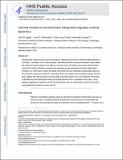Internal models of sensorimotor integration regulate cortical dynamics
Author(s)
Egger, Seth W; Remington, Evan D; Chang, Chia-Jung; Jazayeri, Mehrdad
DownloadAccepted version (2.406Mb)
Publisher Policy
Publisher Policy
Article is made available in accordance with the publisher's policy and may be subject to US copyright law. Please refer to the publisher's site for terms of use.
Terms of use
Metadata
Show full item recordAbstract
© 2019, The Author(s), under exclusive licence to Springer Nature America, Inc. Sensorimotor control during overt movements is characterized in terms of three building blocks: a controller, a simulator and a state estimator. We asked whether the same framework could explain the control of internal states in the absence of movements. Recently, it was shown that the brain controls the timing of future movements by adjusting an internal speed command. We trained monkeys in a novel task in which the speed command had to be dynamically controlled based on the timing of a sequence of flashes. Recordings from the frontal cortex provided evidence that the brain updates the internal speed command after each flash based on the error between the timing of the flash and the anticipated timing of the flash derived from a simulated motor plan. These findings suggest that cognitive control of internal states may be understood in terms of the same computational principles as motor control.
Date issued
2019Department
McGovern Institute for Brain Research at MIT; Massachusetts Institute of Technology. Department of Brain and Cognitive SciencesJournal
Nature Neuroscience
Publisher
Springer Science and Business Media LLC